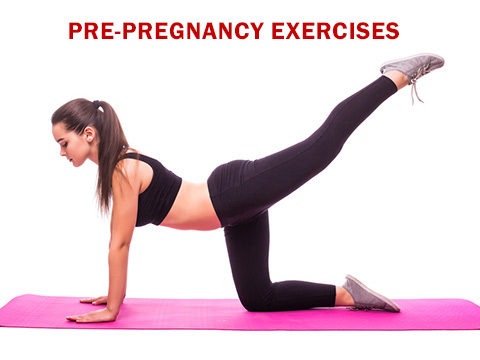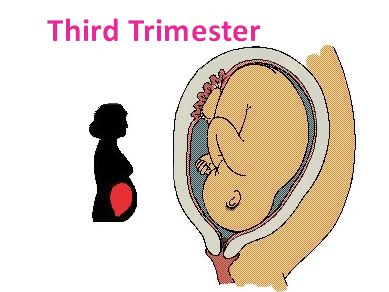Exercises to prepare your body for pregnancy
 Do you want to have a fit and healthy pregnancy and avoid the aches and pains associated with carrying around the extra weight? Get in shape before you conceive. Here’s a look at which pre-pregnancy exercises are most important for your body.
Do you want to have a fit and healthy pregnancy and avoid the aches and pains associated with carrying around the extra weight? Get in shape before you conceive. Here’s a look at which pre-pregnancy exercises are most important for your body.
Many women know about the benefits derived from exercise during pregnancy. Aerobic activity, strength training and stretching can lead to an easier labor and delivery, can help improve posture, which suffers during pregnancy, and can help a woman regain her pre-baby shape quicker. But what about being fit before pregnancy? How important is it and how does it impact fertility?
“We all know exercise improves our mental outlook and endurance and can decrease stress. If you are thinking of becoming pregnant, there are specific childbearing exercises you can do that will strengthen the muscles needed for the childbearing years and after,” says Amy Brummerloh, an exercise physiologist and prenatal and postpartum care expert in New York City.
By stretching and strengthening key muscles, such as the pelvic floor muscles, lower back, shoulders and abdominals, you can decrease the chances of back pain, pulled hamstrings, ligament strains and other aches and pains common to pregnant women, says Brummerloh. In addition, she says a regular exercise routine practiced before and during pregnancy improves blood flow and circulation, which will keep your baby well oxygenated in the womb.
Here are Brummerloh’s recommended exercises to prepare your body for pregnancy:
Back and Shoulders
Seated Row
You can use a row machine or wrap a lightweight (green) resistance band around a sturdy object such as a doorknob or pole about 3 feet off the ground. Sit tall with your legs and shoulder blades together as you pull the handles toward you until your hands are alongside your chest. As you bend your elbows, they should travel directly behind you, not out to the side. Hold briefly and then slowly return to starting position. Beginners should do 1 set of 12 repetitions; intermediate 2 sets, advanced 3 sets.
External Shoulder Rotation
This is a good exercise for posture. Lie on your left side on a mat. Support your head with your bottom arm or a rolled up mat or pillow so your spine stays in alignment. Grasp a 3 to 5-pound dumbbell in your right hand, with your elbow bent 90 degrees and anchored to your side (you can use a rolled up towel under your arm for support). Start with the weight against your body and rotate it up until your forearm points to the ceiling. Lower down and repeat. Beginners should do 1 set of 15 reps; then switch sides and repeat; intermediate and advanced can do 2 sets then switch.
Abs
Crunch
Crunches will strengthen the abs and decrease chance of back pain and abdominal tearing during pregnancy. Lie faceup, knees bent and feet flat on the floor, feet and knees together. Place your hands behind your head. Keep your head and neck relaxed. Contract your abs to bring your shoulders off the floor, hold briefly. Slowly lower to starting position. Before becoming pregnant, you should be doing 50 to 100 crunches at a time. If you are just beginning, do as many as are comfortable.
Butt and Quadriceps
Squat
You can do this exercise free standing or holding on to a stationary object. They strengthen your butt and quadriceps and will make it easier for you to bend down and pick up your baby and other post baby activities. Stand with your feet a little wider than shoulder width apart. Position your arms to hang at your sides. Keep your torso erect and your body weight over your heels. Bend your knees and lower your body as if to sit in a chair until your thighs are as close to parallel to the floor as possible. Do not go lower than this. Come back to the starting position. Beginners should start with 1 set of 12 to 15 repetitions; intermediate and advanced can do 2 or 3 sets.
How to enhance your workout
When at the gym, there are a variety of machines you can use to enhance your workout, including:
- lateral pull-downs,
- lateral raises,
- biceps curls
- triceps extensions.
For the lower body, do some hamstring curls, hip abduction, leg press and calf raises.
Cardiovascular exercise, such as running, cycling and swimming, should be done a minimum of three times per week for approximately 20 to 45 minutes depending on your level of fitness. Beginners should stick to 20 minutes, intermediates should do 30 minutes and advanced can do 40 minutes or more.
Do not exercise too vigorously if you are trying to conceive, cautions Brummerloh. It can increase your chances of injury. In addition, overtraining can lower your level of body fat, which can lead to irregular menstrual cycles and a decrease in estrogen production. Most experts agree that a woman’s body fat should be around 20 to 25 percent. However, there are exceptions. Endurance athletes and other well-trained athletes tend to have low body fat (12 to 15 percent) and have still been able to conceive.
Kegel exercises
The Kegel exercise is a tightening and contracting of the pelvic floor muscles, which are used to control urine flow. The simple exercise when done correctly should feel like you are stopping your urine flow. Brummerloh says it is important to do kegels because they strengthen the pelvic floor muscles that become weakened during the later stages of pregnancy. Sometimes, this can cause urinary incontinence. Thus Brummerloh says it is never too soon to get into the habit of doing this important strengthening exercise.
She suggests the following three ways to do kegel exercises:
- Do a quick set of 50 repetitions, with quick contractions and release movements.
- Do them during your strength training. Always do it on the contraction/breathing-out phase of your exercise.
- Do 20 repetitions and hold each one for 5 seconds.






